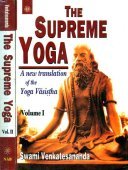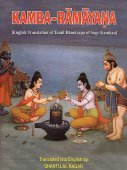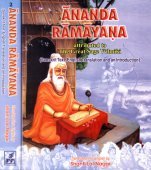Ahalya, Ahalyā: 15 definitions
Introduction:
Ahalya means something in Hinduism, Sanskrit. If you want to know the exact meaning, history, etymology or English translation of this term then check out the descriptions on this page. Add your comment or reference to a book if you want to contribute to this summary article.
Images (photo gallery)
In Hinduism
Purana and Itihasa (epic history)
Source: Wisdom Library: Bhagavata PuranaAhalyā (अहल्या):—The female counterpart of the twin children of Mudgala (one of the five sons of Bharmyāśva), while the male was called Divodāsa. She gave birth to a son named Śatānanda by her husband called Gautama. (see Bhāgavata Purāṇa 9.21.34)
Source: archive.org: Puranic EncyclopediaAhalyā (अहल्या).—Turned into stone by the curse of her husband, Gautama. Ahalyā was a princess of the Pūru dynasty. Genealogy. Descended in order from Viṣṇu as follows: Brahmā-Atri-Candra-Budha-Purūravas-Āyus-Nahuṣa-Yayāti-Pūru-Janamejaya-Prācinvā-Pravīra-Namasyu-Vītabhaya-Śuṇḍu-Bahuvidha-Saṃyāti-Rahovādi-Raudrāśva-Matināra-Santurodha-Duṣyanta-Bharata-Bṛhatkṣetra-Hasti-Ajamīḍha-Nīla-Śānti-Śuśānti-Puruja-Arka-Bharmyaśva-Pāñcāla-Mudgala-Ahalyā. (See full article at Story of Ahalyā from the Puranic encyclopaedia by Vettam Mani)
Source: archive.org: Shiva Purana - English TranslationAhalyā (अहल्या) refers to one of the sixteen celestial ladies (Divyanārī), according to the Śivapurāṇa 2.3.50 (“Description of fun and frolic”).—Accordingly, as Brahmā narrated to Nārada: “[...] Then the sixteen celestial ladies arrived there and saw the couple [i.e., Śiva and Pārvatī] with great respect. They were Sarasvatī, Lakṣmī, Sāvitrī, Jāhnavī, Aditi, Śacī, Lopāmudrā, Arundhatī, Ahalyā, Tulasī, Svāhā, Rohiṇī, Vasundharā, Śatarūpā, Saṃjñā and Rati. There were several virgins of the gods, Nāgas, and the sages. They were charming and attractive. Who can enumerate them? [...]”.
Source: Cologne Digital Sanskrit Dictionaries: The Purana Index1a) Ahalyā (अहल्या).—The daughter of Mudgala, the wife of Gautama and the mother of Śatānanda.1 A tīrtha in her honour, as she performed tapas and attained release there.2
1b) A daughter of Vindhyāśva (Badhyāśva, and wife of Śaradvat; mother of Śadānanda;1 redeemed of her sins by Rāma.2
- 1) Matsya-purāṇa 50. 7-8; Vāyu-purāṇa 99. 201; Viṣṇu-purāṇa IV. 19. 62, 200-2.
- 2) Viṣṇu-purāṇa IV. 4. 91.

The Purana (पुराण, purāṇas) refers to Sanskrit literature preserving ancient India’s vast cultural history, including historical legends, religious ceremonies, various arts and sciences. The eighteen mahapuranas total over 400,000 shlokas (metrical couplets) and date to at least several centuries BCE.
Kavya (poetry)
Source: Wisdom Library: KathāsaritsāgaraAhalyā (अहल्या) is the wife of hermit Gautama by whom she got cursed after he found out her secret affair with Indra, according to the Kathāsaritsāgara, chapter 17. Accordingly, the curse uttered by Gautama ran as follows:—“Harlot, take for a long time the nature of a stone, until thou behold Rāma wandering in the forest.”
The Kathāsaritsāgara (‘ocean of streams of story’), mentioning Ahalyā, is a famous Sanskrit epic story revolving around prince Naravāhanadatta and his quest to become the emperor of the vidyādharas (celestial beings). The work is said to have been an adaptation of Guṇāḍhya’s Bṛhatkathā consisting of 100,000 verses, which in turn is part of a larger work containing 700,000 verses.

Kavya (काव्य, kavya) refers to Sanskrit poetry, a popular ancient Indian tradition of literature. There have been many Sanskrit poets over the ages, hailing from ancient India and beyond. This topic includes mahakavya, or ‘epic poetry’ and natya, or ‘dramatic poetry’.
General definition (in Hinduism)
Source: Apam Napat: Indian MythologyAhalya was a daughter of Lord Brahma. He sent her to the hermitage of sage Gautama to learn the scriptures. When the time came for her marriage, her divine beauty ensured that she did not lack for suitors. Indra, many other Devas and even her teacher Gautama sought her hand in marriage. Brahma announced that he would give her in marriage to the first person who completes traveling around the world. Indra was leading in this race. However, acting on the advice of sage Narada, Gautama walked around a cow. Since the scriptures say that a cow is equal to the whole world, he was adjudged to have won the race. Gautama's marriage with Ahalya was duly celebrated. They had a son named Shataananda.
Languages of India and abroad
Sanskrit dictionary
Source: DDSA: The practical Sanskrit-English dictionaryAhalya (अहल्य).—a.
1) Unploughed.
2) Not arable.
-lyaḥ Name of a country.
-lyā Name of the wife of Gautama [According to the Rāmāyana she was the first woman created by Brahmā, who gave her to Gautama. She was seduced by Indra who assumed the form of her husband and so deceived her, or, according to another version, she knew the god and was flattered by the great God's condescension. There is another story which states that Indra secured the assistance of the moon who, assuming the form of a cock, crowed at mid-night. This roused Gautama to his morning devotions, and Indra went in and took his place. Gautama, when he knew of her seduction expelled her from his hermitage and cursed her to be a stone and become invisible till she should be touched by the feet of Dāśarathi Rāma which would restore her to her former shape. Rāma afterwards delivered her from her wretched state and she was reconciled to her husband. Ahalyā is one of the five very chaste and pure women whose names every one is recommended to repeat in the morning; अहल्या द्रौपदी सीता तारा मन्दोदरी तथा । पञ्चकं ना स्मरेन्नित्यं महापातकनाशनम् (ahalyā draupadī sītā tārā mandodarī tathā | pañcakaṃ nā smarennityaṃ mahāpātakanāśanam) || Kumārila Bhaṭṭa explains the seduction of Ahalyā as Indra's (the sun's) carrying away the shades of night, Ahalyā signifying night.] For a very succinct account, see also Mv.1.
2) Name of a sea.
Source: Cologne Digital Sanskrit Dictionaries: Shabda-Sagara Sanskrit-English DictionaryAhalya (अहल्य).—mfn.
(-lyaḥ-lyā-lyaṃ) Unploughed, (a field, &c.) f.
(-lyā) 1. The name of an Apsaras or heavenly courtezan. 2. The wife of Gautama, a saint and philosopher. E. a neg. hala to plough, yat aff.
Source: Cologne Digital Sanskrit Dictionaries: Benfey Sanskrit-English DictionaryAhalyā (अहल्या).—f. The wife of Gautama, [Daśakumāracarita] in
Ahalyā (अहल्या).—[feminine] [Name] of the wife of Gautama.
Source: Cologne Digital Sanskrit Dictionaries: Monier-Williams Sanskrit-English Dictionary1) Ahalyā (अहल्या):—[=a-halyā] [from a-hala] f. Name of the wife of Gautama or Śaradvat, [Śatapatha-brāhmaṇa iii, etc.; Mahābhārata] etc.
2) [v.s. ...] Name of an Apsaras, [cf. Lexicographers, esp. such as amarasiṃha, halāyudha, hemacandra, etc.]
3) [v.s. ...] of a lake (cf. [Mahābhārata iii, 8087]), [cf. Lexicographers, esp. such as amarasiṃha, halāyudha, hemacandra, etc.]
Source: Cologne Digital Sanskrit Dictionaries: Yates Sanskrit-English Dictionary1) Ahalya (अहल्य):—[a-halya] (lyaḥ-lyā-lyaṃ) a. Idem.
2) Ahalyā (अहल्या):—[a-halyā] (lyā) 1. f. Idem; an Apsara; wife of Gautama.
Source: DDSA: Paia-sadda-mahannavo; a comprehensive Prakrit Hindi dictionary (S)Āhalyā (आहल्या) in the Sanskrit language is related to the Prakrit word: Āhallā.
[Sanskrit to German]
Sanskrit, also spelled संस्कृतम् (saṃskṛtam), is an ancient language of India commonly seen as the grandmother of the Indo-European language family (even English!). Closely allied with Prakrit and Pali, Sanskrit is more exhaustive in both grammar and terms and has the most extensive collection of literature in the world, greatly surpassing its sister-languages Greek and Latin.
See also (Relevant definitions)
Partial matches: Halya, Alya, A.
Starts with: Ahalyahrada, Ahalyajara, Ahalyakamadhenu, Ahalyanandana, Ahalyapalli, Ahalyapati, Ahalyasamkrandana, Ahalyastotra, Ahalyatirtha, Ahalyeshvaratirtha.
Ends with: Bahalya, Ekahalya, Mahalya, Nahalya, Tahalya.
Full-text (+50): Ahalyajara, Ahalyakamadhenu, Shatananda, Ahalyahrada, Ahalla, Ahalyasamkrandana, Ahalyeshvaratirtha, Ahilya, Alikai, Gautama, Ahalyanandana, Ahalyapati, Akaliyai, Gotami, Pancakanya, Netrayoni, Mandodari, Shataananda, Gotama, Mudgala.
Relevant text
Search found 45 books and stories containing Ahalya, Ahalyā, A-halya, A-halyā, Āhalyā; (plurals include: Ahalyas, Ahalyās, halyas, halyās, Āhalyās). You can also click to the full overview containing English textual excerpts. Below are direct links for the most relevant articles:
Laghu-yoga-vasistha (by K. Narayanasvami Aiyar)
Part 5 - The Story of the Deceitful Indra < [Chapter III - Utpatti-prakaraṇa]
The Gautami Mahatmya (by G. P. Bhatt)
Chapter 16 - Indra-tīrtha or Ahalyā-saṅgama-tīrtha
Chapter 39 - Cakra-tīrtha (for the sake of the discus)
Is Ahalya Controversial? < [January – March, 2000]
Ahalya < [January – March 1992]
Viswamitra-Ahalya < [April – June and July – September, 1996]
Ramayana of Valmiki (by Hari Prasad Shastri)
Chapter 49 - Shri Rama liberates Ahalya from Gautama’s curse < [Book 1 - Bala-kanda]
Chapter 48 - Gautama’s hermitage < [Book 1 - Bala-kanda]
Chapter 30 - Telling of the Curse pronounced by the Sage Gautama on Shakra < [Book 7 - Uttara-kanda]
The Skanda Purana (by G. V. Tagare)
Chapter 136 - The Greatness of Ahalyā Tīrtha < [Section 3 - Revā-khaṇḍa]
Chapter 208 - Greatness of Gautameśvara, Ahalyeśvara and Śatānandeśvara < [Section 1 - Tīrtha-māhātmya]
Chapter 52 - The Story of Koṭitīrtha < [Section 2 - Kaumārikā-khaṇḍa]
Puranic encyclopaedia (by Vettam Mani)
Related products





